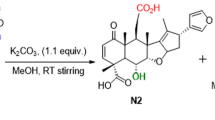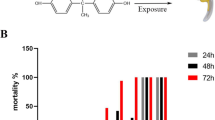Abstract
Objective: Borneol is a widely used Chinese medicine, and borneol extracted from plants or synthesized are the two major types of borneol applied in clinical therapy. In this study, the hepatotoxicity of natural and synthetic borneol in both larval and adult zebrafish was detected. Methods: Adult fish and larval were exposed to borneol. Results: Synthetic borneol induced more obvious developmental toxicity, such as morphological deformity, delay of yolk sac absorption, disappearance of swim bladder, loose hepatic tissue, irregular cells, cell vacuolation and decline in cell count; treatment with synthetic borneol caused more severe oxidative stress, as changes in the activities of CAT and SOD and accumulation of ROS and MDA are more notable; synthetic borneol could disrupt lipid and glycogen metabolism more seriously possibly due to the more notable expression changes of metabolismrelated genes (ide, sirt4, dgat1b, and mgst1); synthetic borneol possibly produced hepatic injury by inducing cell apoptosis. Discussion: Our results suggest synthetic borneol has greater potential to cause hepatotoxicity compare to natural borneol. Conclusions: SB showed higher developmental toxicity than NB in larval zebrafish. Exposure to SB disordered the liver’s lipid and glycogen metabolism caused by liver injury in higher concentration groups These findings have implications for understanding the mechanism of the hepatotoxicity caused by borneol, and provide a scientific basis for the drug safety of borneol.








Similar content being viewed by others
DATA AVAILABILITY
The data that support the findings of this study are available from the corresponding author upon reasonable request.
REFERENCES
Guo, S.Y., Zhu, X.Y., Liao, W.H., and Li, C.Q., Exp. Animal Sci., 2016, vol. 33, pp. 21–27. https://doi.org/10.3969/j.issn.1006-6179.2016.05.004
Liu, Y., Zhong, Q.X., Qiu, H.H., Wang, G., Wang, C.C., Feng, L., and Jia, X.B., China J. Chinese Mat. Medica, 2017, vol. 42, pp. 3044–3048. https://doi.org/10.19540/j.cnki.cjcmm.20170714.011
Yoshioka, H., Usuda, H., Fujii, H., and Nonogaki, T., Environ Health Prev. Med., 2017, vol. 22, p. 54. https://doi.org/10.1186/s12199-017-0662-3
Liu, Y., Zhang, B.L., and Hu, L.M., Tianjin J. Tradit. Chinese Med., 2003, vol. 20, pp. 85–87. https://doi.org/10.3969/j.issn.1672-1519.2003.04.046
Zhang, R., Mi, S.Q., and Wang, N.S., Eur. J. Drug Metab. Pharmacokinet, 2013, vol. 38, pp. 159–169. https://doi.org/10.1007/s13318-013-0125-1
Chen, J.Y., Wang, J.J., Meng, M.R., and Chen, Y., Acta Pharm. Sinica, 2015, vol. 50, pp. 459–463. https://doi.org/10.16438/j.0513-4870.2015.04.004
Zhan, H.W., Liu, H.B., Ye, X.J., Wang, J., and Fang, S.W., Mod. Drug Appl., 2012, vol. 6, pp. 1–3. https://doi.org/10.14164/j.cnki.cn11-5581/r.2012.22.012
Wu, C., Liao, Q., Yao, M., Xu, X., Zhou, Y., Hou, X., and Xie, Z., Eur. J. Drug Metab. Pharmacokinet., 2014, vol. 39, pp. 17–24. https://doi.org/10.1007/s13318-013-0135-z
He, X.J., Lv, Q.J., and Liu, Y.L., West China J. Pharm. Sci., 2006, vol. 21, pp. 523–526. https://doi.org/10.13375/j.cnki.wcjps.2006.06.005
Huang, P., Jiang, X.F., Zou, J.L., Yuan, Y.M., and Yao, M.C., World Sci. Technol. Modern. Tradit. Chinese Med. Mat. Med., 2009, vol. 11, pp. 821–827. https://doi.org/10.3969/j.issn.1674-3849.2009.06.012
Saravanakumar, M., Manivannan, J., Sivasubramanian, J., Silambarasan, T., Balamurugan, E., and Raja, B., Mol. Cell Biochem., 2012, vol. 362, pp. 203–209. https://doi.org/10.1007/s11010-011-1143-4
Yin, Y., Cao, L., Ge, H., Duanmu, W., Tan, L., Yuan, J., Tunan, C., Li, F., Hu, R., Gao, F., and Feng, H., Neuroreport, 2017, vol. 28, pp. 506–513. https://doi.org/10.1097/WNR.0000000000000792
Zhao, B.S. and Liu, Q.D., Tradit. Chinese Drug Res. Clin. Pharmacol., 2002, vol. 13, pp. 287–288. https://doi.org/10.19378/j.issn.1003-9783.2002.05.007
Chen, Y.J., Pu, Y.Z., Yan, H., Zhong, Y.X., Wang, Z., Li, C.J., Zha, X.D., Zhao, B.Q., and Liu, P., China Pharmacy, 2014, vol. 25, pp. 1733–1737. https://doi.org/10.6039/j.issn.1001-0408.2014.19.02
Hu, L.M., Jiang, M., Ling, S., Fan, G.W., Gao, X.M., and Zhang, B.L., J. Toxicology, 2006, vol. 20, pp. 275–276. https://doi.org/10.16421/j.cnki.1002-3127.2006.04.030
Jia, K., Cheng, B., Huang, L., Xiao, J., Bai, Z., Liao, X., Cao, Z., Shen, T., Zhang, C., Hu, C., and Lu, H., Chemosphere, vol. 248, p. 125941. https://doi.org/10.1016/j.chemosphere.2020.125941
Jin, Y., Liu, Z., Peng, T., and Fu, Z., Fish Shellfish Immunol., 2015, vol. 43, pp. 405–414.
Liu, Z., Fu, Z., and Jin, Y., Chemosphere, 2017, vol. 166, pp. 212–220. https://doi.org/10.1016/j.chemosphere.2016.09.100
Tilton, F.A., Bammler, T.K., and Gallagher, E.P., Comp. Biochem. Physiol. C Toxicol. Pharmacol., 2011, vol. 153, pp. 9–16. https://doi.org/10.1016/j.cbpc.2010.07.008
Wang, Y., Dai, D., Yu, Y., Yang, G., Shen, W., Wang, Q., Weng, H., and Zhao, X., J. Hazardous Mat., 2018, vol. 352, pp. 80–91. https://doi.org/10.1016/j.jhazmat.2018.03.023
Glaberman, S., Padilla, S., and Barron, M.G., Environ. Toxicol. Chem., 2017, vol. 36, pp. 1221–1226. https://doi.org/10.1002/etc.3641
Zeng, C., Sun, H., Xie, P., Wang, J., Zhang, G., Chen, N., Yan, W., and Li, G., Aquat. Toxicol., 2014, vol. 149, pp. 25–32. https://doi.org/10.1016/j.aquatox.2014.01.021
Jiang, G.C., Yang, S.H., and Feng, X.J., West China J. Pharm. Sci., 1990, vol. 5, pp. 190–191. https://doi.org/10.13375/j.cnki.wcjps.1990.03.023
Oliveira, R., Grisolia, C.K., Monteiro, M.S., Soares, A.M., and Domingues, I., Comparative Biochem. Physiol. Part C: Toxicol. Pharmacol., 2016, vol. 187, pp. 50–61. https://doi.org/10.1016/j.cbpc.2016.04.004
Pamanji, R., Yashwanth, B., Bethu, M.S., Leelavathi, S., Ravinder, K., and Rao, J.V., Environ. Toxicol. Pharmacol., 2015, vol. 39, pp. 887–897. https://doi.org/10.1016/j.etap.2015.02.020
Patricia, M., John Wiley and Sons, Inc., Hoboken, 2011, Ch. 8, pp. 12–14. https://doi.org/10.1002/9781118102138
Rajaraman, G., Wang, G.Q., Yan, J., Jiang, P., Gong, Y., and Burczynski, F.J., Mol. Cell Biochem., 2007, vol. 295, pp. 27–34. https://doi.org/10.1007/s11010-006-9268-6
Jonsson, M.E., Kubota, A., Timme-Laragy, A.R., Woodin, B., and Stegeman, J.J., Toxicol. Appl. Pharmacol., 2012, vol. 265, pp. 166–174. https://doi.org/10.1016/j.taap.2012.09.023
Li, X.S., jiang, X., Ding, G.H., Ma, X.L., Qi, Z.X., and Xiong, D.Q., Asian J. Ecotoxicol., 2017, vol. 12, pp. 281–290. https://doi.org/10.1007/s00128-018-2413-6
Ahmed, M.K., Habibullah-Al-Mamun, M., Parvin, E., Akter, M.S., and Khan, M.S., Exp. Toxicol. Pathol., 2013, vol. 65, pp. 903–909. https://doi.org/10.1016/j.etp.2013.01.003
Al-Bairuty, G.A., Shaw, B.J., Handy, R.D., and Henry, T.B., Aquat. Toxicol., 2013, vol. 126, pp. 104–115. https://doi.org/10.1016/j.aquatox.2012.10.005
Ameur, W.B., El Megdiche, Y., de Lapuente, J., Barhoumi, B., Trabelsi, S., Ennaceur, S., Camps, L., Serret, J., Ramos-Lopez, D., Gonzalez-Linares, J., Touil, S., Driss, M.R., and Borras, M., Chemosphere, 2015, vol. 135, pp. 67–74. https://doi.org/10.1016/j.chemosphere.2015.02.050
Devi, G.P., Ahmed, K.B., Varsha, M.K., Shrijha, B.S., Lal, K.K., Anbazhagan, V., and Thiagarajan, R., Aquat. Toxicol., 2015, vol. 158, pp. 149–156. https://doi.org/10.1016/j.aquatox.2014.11.007
Jones, A., Trends Plant Sci., 2000, vol. 5, pp. 225–230. https://doi.org/10.1016/s1360-1385(00)01605-8
Zhang, H.B., Xia, Y., Wang, P.F., Lv, W.P., and Chen, Y.L., World Latest Med. Inf., 2017, vol. 17, pp. 66–68. https://doi.org/10.3969/j.issn.1671-3141.2017.34.032
Cui, Y., Liu, W., Xie, W., Yu, W., Wang, C., and Chen, H., Int. J. Environ Res. Public Health, 2015, vol. 12, pp. 15673–15682. https://doi.org/10.3390/ijerph121215012
Liu, L., Zhao, Q.F., Jin, K.X., Zhu, S.Q., Wang, X.F., and Lu, J.Y., Huan Jing Sci., 2015, vol. 36, pp. 3884–3891. https://doi.org/10.13227/j.hjkx.2015.10.044
Okal, A., Mossalam, M., Matissek, K.J., Dixon, A.S., Moos, P.J., and Lim, C.S., Mol. Pharm., 2013, vol. 10, pp. 3922–3933. https://doi.org/10.1021/mp400379c
Liu, L., Jiang, C., Wu, Z.Q., Gong, Y.X., and Wang, G.X., Ecotoxicol. Environ Saf., 2013, vol. 98, pp. 297–302. https://doi.org/10.1016/j.ecoenv.2013.10.011
Tang, C., Chai, X., Kang, F., Huang, X., Hou, T., Tang, F., and Li, J., Mediat. Inflamm., 2015, vol. 2015, Article ID: 965925. https://doi.org/10.1155/2015/965925
Feng, M., Qu, R., Wang, C., Wang, L., and Wang, Z., Aquat. Toxicol., 2013, vol. 140–141, pp. 314–323. https://doi.org/10.1016/j.aquatox.2013.07.001
Lushchak, V.I., Aquat. Toxicol., 2011, vol. 101, pp. 13–30. https://doi.org/10.1016/j.aquatox.2010.10.006
Krapivner, S., Iglesias, M.J., Silveira, A., Tegner, J., Bjorkegren, J., Hamsten, A., and van’t Hooft, F.M., Arterioscler Thromb. Vasc. Biol., 2010, vol. 30, pp. 962–967. https://doi.org/10.1161/ATVBAHA.109.201426
Lu, X., Huang, Y., Liu, Y., Wu, X., and Shi, X., Metabolism, 2009, vol. 58, pp. 1465–1469. https://doi.org/10.1016/j.metabol.2009.04.027
Ufer, C., Wang, C.C., Borchert, A., Heydeck, D., and Kuhn, H., Antioxid. Redox. Signal, 2010, vol. 13, pp. 833–875. https://doi.org/10.1089/ars.2009.3044
Qiu, L., Jia, K., Huang, L., Liao, X., Guo, X., and Lu, H., Chemosphere, 2019, vol. 232, pp. 171–179. https://doi.org/10.1016/j.chemosphere.2019.05.159
Liu, Y., Wang, J., Wei, Y., Zhang, H., Xu, M., and Dai, J., Aquat. Toxicol., 2008, vol. 89, pp. 242–250. https://doi.org/10.1016/j.aquatox.2008.07.009
ACKNOWLEDGMENTS
The authors thank for Jun Zhou (Jiangxi Linke Longnao Co., LTD) for providing free the borneol.
Funding
This work was supported by the Key Science and technology Projects of Ji’an city (no. 20211-055455), Jinggangshan University Local Service Project (nos. JFD1804 and JFD1904).
Author information
Authors and Affiliations
Contributions
The authors XL and KJ writing original draft, methodology, formal analysis, editing, and funding acquisition. The author LH—formal analysis, methodology. The author ZC— validation, methodology. The author HL—validation, methodology, supervision, and funding acquisition.
All authors participated in the discussions.
Corresponding author
Ethics declarations
This article does not contain any studies involving patients or animals as test objects.
Informed consent was not required for this article. No conflict of interest was declared by the authors.
Additional information
Publisher's Note. Pleiades Publishing remains neutral with regard to jurisdictional claims in published maps and institutional affiliations.
Supplementary information
Rights and permissions
About this article
Cite this article
Liao, X., Jia, K., Huang, L. et al. Borneol Induced Hepatotoxicity via Caspase-3 and Oxidative Stress Pathwaysin in Zebrafish. Russ J Bioorg Chem 50, 508–521 (2024). https://doi.org/10.1134/S1068162024020080
Received:
Revised:
Accepted:
Published:
Issue Date:
DOI: https://doi.org/10.1134/S1068162024020080




